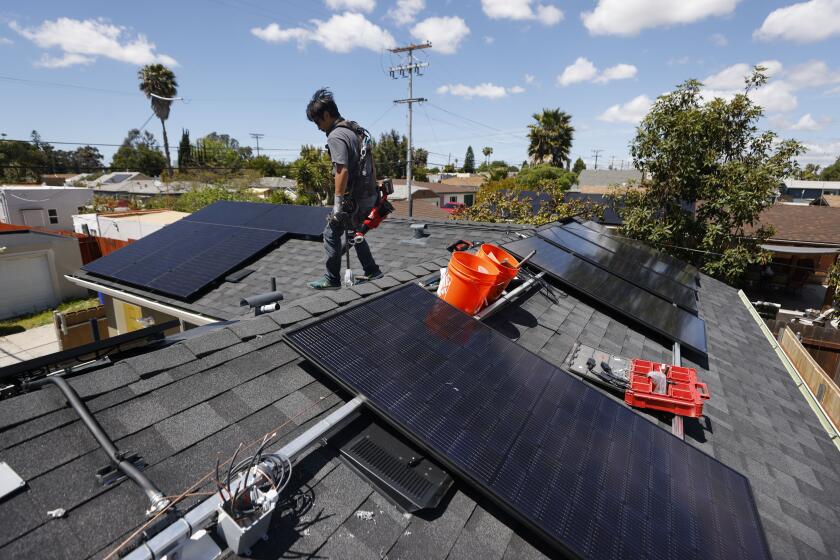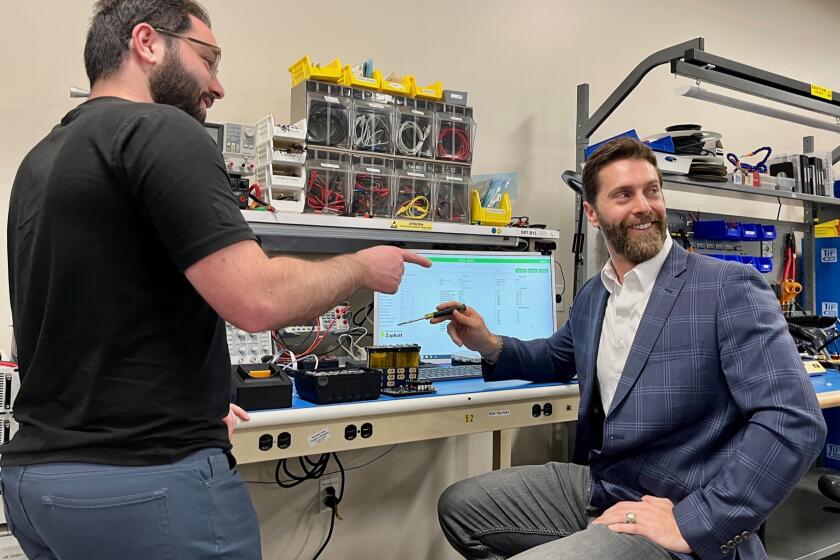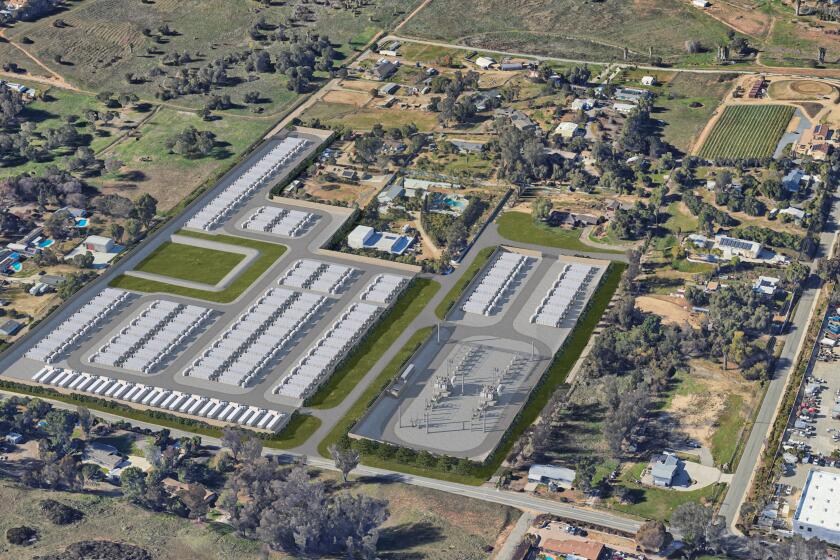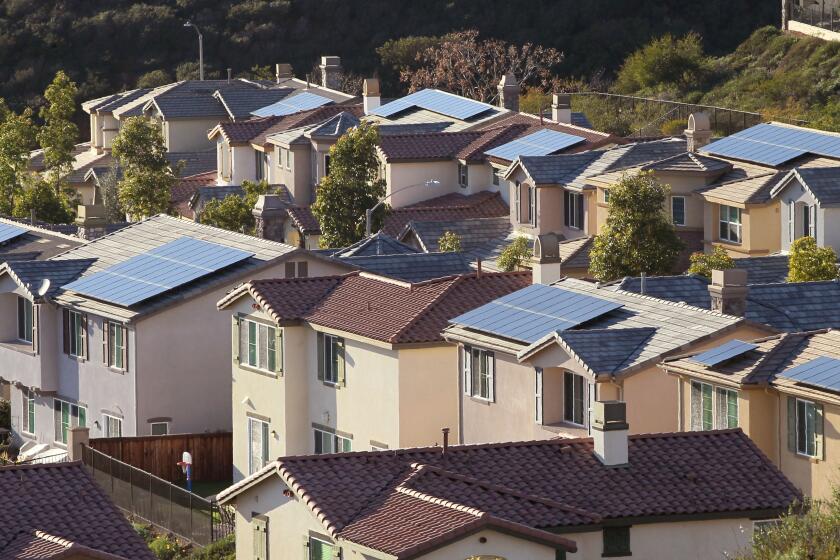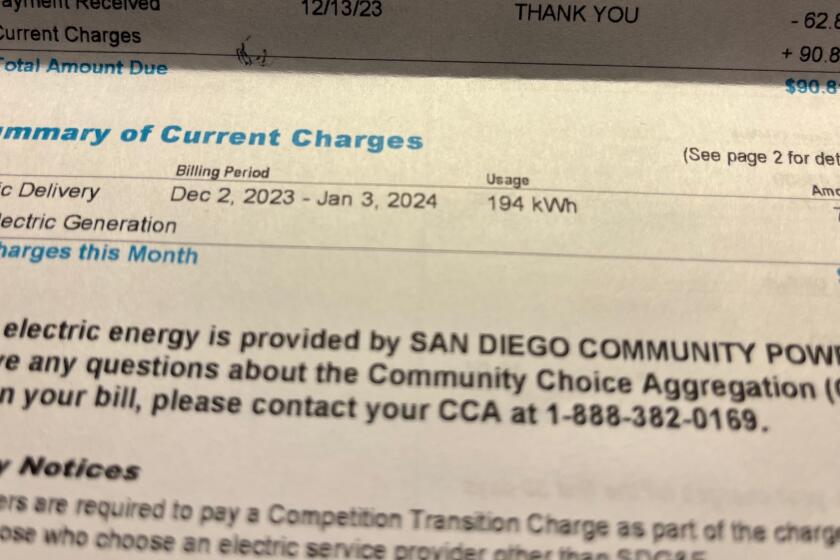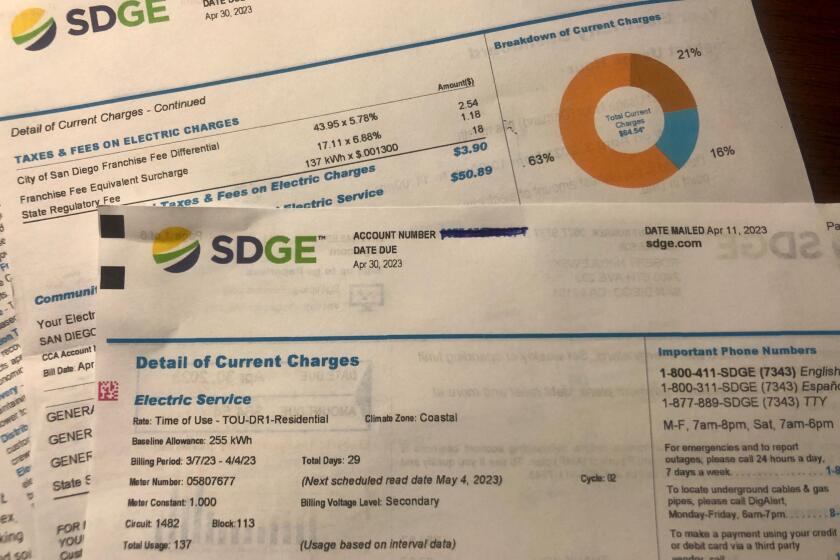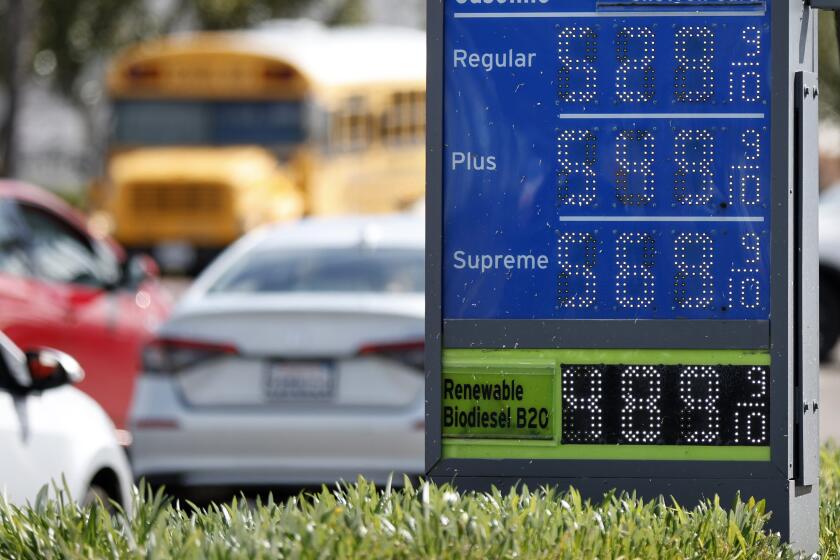SDG&E to add five new battery storage facilities

In California’s quest to blend more renewable energy sources into the power grid, energy storage has repeatedly become one of the answers the state’s policymakers have turned to.
Late last week, the California Public Utilities Commission (CPUC) approved a proposal from San Diego Gas & Electric to build five new energy storage projects, each using lithium-ion battery technology, at facilities in San Diego, Poway, Escondido, Fallbrook and San Juan Capistrano.
The projects will total 83.5 megawatts — enough to power about 55,000 homes for four hours.
“Energy storage acts as a kind of shock absorber” for the electrical system, SDG&E president Scott Drury said Monday at a news conference.
Renewables have a problem with intermittency — that is, solar power slumps when the sun goes down and wind energy wanes when the breeze tapers off.
Conversely, so much solar is currently generated in California during the day that the California Independent System Operator (the organization which oversees the operation of about 80 percent of the state’s electric power system) often has to send the excess to neighboring states like Arizona or curtail solar altogether.
Essentially, batteries store up energy that can then be deployed to help fill in the gaps.
“These batteries and other projects like them allow us to absorb that excess and then call on it at other times of the day when it’s needed,” Drury said. SDG&E already boasts a 30-megawatt lithium-ion battery energy storage center — at the time of its debut the largest of its kind in the world — at the utility’s operations center in Escondido.
Energy storage technologies can also help the state’s power mix become less reliant on natural gas, which is the single largest fuel type for in-state electric generation — 49.86 percent in 2016.
With battery storage, “you don’t have the emissions concerns and other things associated with that and you don’t have to worry about bringing in natural gas for it either,” said Craig Horne, a vice president at RES, a global renewable energy company with its North American office based in Denver. “So you’re just using the existing electricity network.”
RES is building one of the five lithium-ion projects SDG&E announced on Monday, a 30-megawatt facility expected to be completed by the end of next year at the SDG&E Miramar substation.
Energy storage comes in a variety of forms, including pumped hydro, in which water is pumped uphill behind dams and then released, with the ensuing rush of water generating power. But increasingly, battery storage has become a preferred technology as electric vehicles using lithium-ion batteries become more widespread.
California’s ambitious clean-air and renewables mandates have also boosted storage solutions, since they do not directly lead to greenhouse gas emissions.
California policymakers want to reduce greenhouse gas emissions to 80 percent below 1990 levels by 2050 and utilities have been directed to derive 50 percent of electricity from clean-energy sources by 2030.
Regulatory requirements laid down by the state
Responding to state law, the CPUC directed the big three investor-owned utilities to make contracts to procure 1,325 megawatts of energy storage by 2020. Pacific Gas & Electric and Southern California Edison were given targets of 580 megawatts each while SDG&E’s responsibility came to 165 megawatts.
The five contracts will put SDG&E just a few megawatts shy of reaching the CPUC’s mandated goals.
Yet another law has called on each utility to find another 166 megawatts in energy storage projects. SDG&E recently filed an application with the CPUC for seven facilities that would account for 100 megawatts of the target.
So does SDG&E take on energy storage projects because it’s good business or because the CPUC makes the utility do it?
“We think the adoption of advanced technologies to make the grid more resilient and enable renewable energy is good public policy and good for our customers and that’s why we do it,” said Drury.
Energy storage does have its skeptics, many of whom say it’s too expensive.
Stephen Brick, senior adviser to the Boston-based Clean Air Task Force, has studied the cost of energy storage technologies, including batteries.
“The batteries themselves are probably in the $250 per kilowatt-hour neighborhood today,” Brick said.
But there are additional costs, Brick said, such as using an inverter to take the direct current (DC) from the battery to align with alternating current (AC) from the grid. There are interconnection costs to take into account as well.
“Even at a very high utilization rate, like using it three out of four days, you’re still talking about a 15-cent per kilowatt-hour resource, just for the storage,” Brick said. “Remember, wholesale prices in California last year, were around 3-½ cents per kilowatt-hour on average.”
Fans of storage counter by citing how much costs have gone down in recent years. For example, lithium-ion battery projects in the early 1990s cost about $10,000 a kilowatt-hour.
Charles Vaughan, managing director at Fluence, the company building SDG&E’s 40-megawatt battery storage facility in Fallbrook, said commitments by car makers to dramatically expand the production of electric vehicles will help the battery storage sector. Earlier this year, Volkswagen promised to build at least 16 EV plants by 2025.
“For stationary energy storage for utilities, we’re benefiting from all of that investment in economies of scale,” Vaughn said.
Vaughn said the Fallbrook storage facility is expected to begin operations in 2021.
California energy storage mandates
Under Assembly Bill 2514
Pacific Gas & Electric — 580 megawatts
Southern California Edison — 580 megawatts
SDG&E — 165 megawatts
Total: 1,325 megawatts
Under Assembly Bill 2868
Pacific Gas & Electric — 166.6 megawatts
Southern California Edison — 166.6 megawatts
SDG&E — 166.6 megawatts
Total: 500 megawatts
This story as been updated to say the North American office for RES is based in Denver.
Business
rob.nikolewski@sduniontribune.com
(619) 293-1251 Twitter: @robnikolewski
Get U-T Business in your inbox on Mondays
Get ready for your week with the week’s top business stories from San Diego and California, in your inbox Monday mornings.
You may occasionally receive promotional content from the San Diego Union-Tribune.


